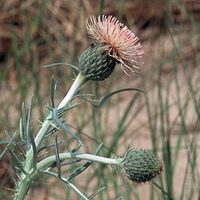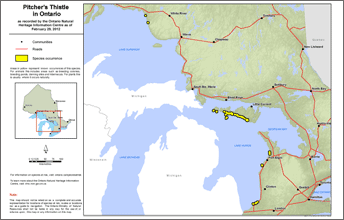Pitcher’s Thistle
Scientific name: Cirsium pitcheri

Cover photo credit: Allen Woodliffe
Status
Threatened
“Threatened” means the species lives in the wild in Ontario, is not endangered, but is likely to become endangered if steps are not taken to address factors threatening it.
Date added to the Species at Risk in Ontario List
June 8, 2011
What it looks like
The Pitcher’s Thistle is unlikely to be mistaken for the more common thistles of Ontario roadsides and old fields. The stem and leaves are slender and covered in fine, whitish fuzz. The main stem can be up to one metre in height, and the leaves are greyish-green and deeply divided into narrow, spine-tipped segments.
This species may grow for many years before flowering. It eventually produces between two and 125 flowering heads, made up of many small pinkish or creamy-white flowers that provide a source of nectar for bees and other insects. The seeds have a downy white “parachute” and can be carried by the wind some distance from the parent plant.
Where it lives
The Pitcher’s Thistle grows in windblown sandy habitats, especially on coastal sand dune ridges, among grasses and other plants. It requires a moderate amount of sand movement, and open, bare areas among the vegetation.
Where it’s been found in Ontario
The global population of the Pitcher’s Thistle is limited to the Great Lakes basin of Canada and the United States.
In Canada, the Pitcher’s Thistle is found only in Ontario where it is believed to be restricted to 30 sites: three on the Lake Huron shoreline south of the Bruce Peninsula, two on the Lake Superior shoreline and the remainder in the Manitoulin region.
View a larger version of this map (PDF)
What threatens it
The main threats to Pitcher’s Thistle are habitat loss and degradation as a result of urban development, excessive recreational use of beaches, including ATV use on sand dunes, and changes in normal sand build-up due to shoreline modifications.
Natural factors, such as browsing by White-tailed Deer, are also a threat to this thistle.
Action we are taking
Threatened species and their general habitat are automatically protected.
Recovery strategy
A recovery strategy advises the ministry on ways to ensure healthy numbers of the species return to Ontario.
Read the executive summary (May 31, 2013)
Read the recovery strategy (May 31, 2013)
Government response statement
A government response statement outlines the actions the government intends to take or support to help recover the species.
Read the government response statement (March 14, 2014)
Review of progress
A review of progress made toward protecting and recovering a species is required no later than the time specified in the species’ government response statement, or not later than five years after the government response statement is published if no time is specified.
Read the report on progress towards the protection and recovery of 16 species at risk, including Pitcher’s Thistle (Cirsium pitcheri) (2019).
Habitat protection
A habitat regulation defines a species’ habitat and may describe features (e.g., a creek, cliff, or beach), geographic boundaries or other unique characteristics.
Read the habitat summary (January 1, 2015)
Read the regulation (January 1, 2015)
What you can do
Report a sighting
Report a sighting of an endangered animal or plant to the Natural Heritage Information Centre. Photographs with specific locations or mapping coordinates are always helpful.
Volunteer
Volunteer with your local nature club or provincial park to participate in surveys or stewardship work focused on species at risk.
Be a good steward
- Private land owners have a very important role to play in species recovery; if you find Pitchers thistle on your land, you may be eligible for stewardship programs that support the protection and recovery of species at risk and their habitats.
- Invasive species seriously threaten many of Ontario’s species at risk; to learn what you can do to help reduce the threat of invasive species, visit:
- Pollinators, such as bees, are in steep decline across the globe and they play a key role in the survival of many of Ontario’s rare plants; for information on how you can help scientists monitor pollinator populations in Ontario visit Seeds of Diversity.
Report illegal activity
Report any illegal activity related to plants and wildlife to
Quick facts
- Pitcher’s Thistle was named after Dr. Zina Pitcher, who discovered the plant while serving as an army surgeon during the 1820s at Fort Brady, Sault Ste. Marie on Lake Superior.
- Pitcher’s Thistle will grow without flowers for three to 11 years before flowering once and then dying.
- Pitcher’s Thistle can be confused with a common sand dune plant called Wormwood. Wormwood leaves are more finely divided, often purple at the base and have no spines.
- This Thistle has a delicate relationship with its sandy habitat; partial natural burial in sand, which happens due to wind and storm events, stimulates growth of this plant, but too much can kill them.
